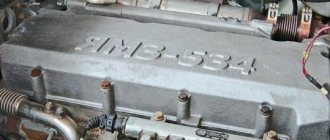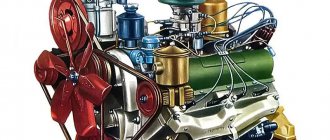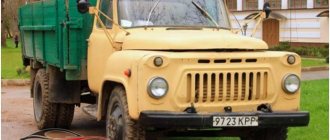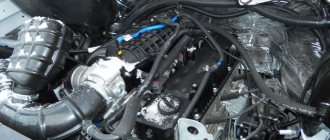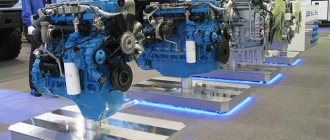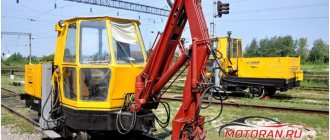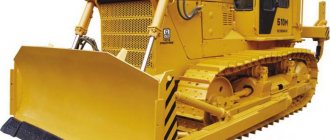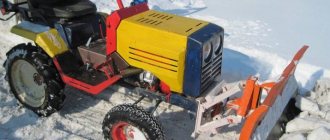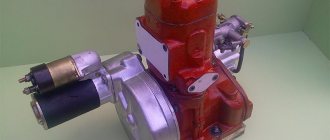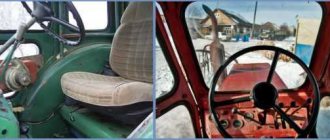Dimensional drawings
diesel engine MMZ D-243 / MMZ D-243:
Characteristics
This is interesting: Engine chip tuning: pros and cons
Peculiarities
Technical characteristics of D 243:
- The power unit has 4 working cylinders.
- The order of ignition of the combustible mixture is: 1-3-4-2.
- The cylinders have a diameter of 11 cm.
- The piston travels a distance of 12.5 cm in one cycle.
- The total working volume of the cylinders is 4.75.
- Engine power - 60 kW.
- The torque value at 600 rpm is 298 N*m.
- Compression ratio – 16.
- Diesel consumption – 226 g/kWh.
- Oil pressure at maximum engine speed is 0.08 MPa.
- Oil pressure at nominal speed is 0.25-0.35 MPa.
- The motor weighs 490 kg.
- Oil volume – 12 l.
- Diesel can be operated at temperatures from -45 to +40 degrees.
Diesel engine
The price of a new D 243 engine is 153,100 rubles.
Operating experience of the MTZ-80 Belarus tractor: Brake control
This mode of operation of the gas distribution mechanisms ensures greater air saturation of the internal cavities of the cylinders and better removal of exhaust gases from them. Many years of experience in the electrical equipment market, cooperation with manufacturing plants, as well as the availability of products in our warehouses, allows us to purchase and deliver electrical equipment and components in the shortest possible time.
| Production | MMZ |
| Engine make | D243 |
| Years of manufacture | 1974-present |
| Cylinder block material | cast iron |
| engine's type | diesel |
| Configuration | in-line |
| Number of cylinders | 4 |
| Valves per cylinder | 2 |
| Piston stroke, mm | 125 |
| Cylinder diameter, mm | 110 |
| Compression ratio | 16 |
| Engine capacity, cc | 4750 |
| Engine power, hp/rpm | 60/2200 81/2200 83/2200 |
| Torque, Nm/rpm | 274/- 298/1600 298/1600 |
| Environmental standards | Euro 0 Euro 1 |
| Turbocharger | — |
| Engine weight, kg | 430 (D243) |
| Fuel consumption, l/hour (for GS-10.01) | 8.8 |
| Oil consumption, % of fuel consumption, up to | 1.1 |
| Engine oil | 5W-40 15W-40 |
| How much oil is in the engine, l | 12 |
| Oil change is carried out, hours | 500 |
| Dimensions, mm: - length - width - height | 1003 676 1223 |
| Engine life, hours - according to factory data - in practice | 8 000 — |
| Tuning, hp — potential — without loss of resource | 100+ — |
| The engine was installed | MTZ-80, 82, 892, 952 MTZ MT-353, MP-403, MGL-363, MMP-393, MPL-373 TTZ-80 Belarus-90, 820, 821, 900 EK-12, EK-14 EO- 3323 VP-05-04 Loaders 41008 Zlata, 40810, 41015, 41306 AD30, AD60 ADD-4004 ED30 DU-98, 100 MZ Arsenal Amkodor-6641, 6622 |
Maintenance and oil change
The D-243 engine does not have significant differences from the 240 model. Engine maintenance is carried out every 20-25 thousand kilometers.
Scheduled maintenance of an internal combustion engine is a set of operations aimed at preserving the primary condition of the components and parts of the unit.
D243 on a Belarus tractor
According to the repair and operation manual for the D series motor compiled by the manufacturer, we will consider what operations are included in the maintenance of the 243rd:
- Change of oil.
- Adjusting the valve mechanism.
- Replacing filters. So, depending on the engine modification, the following filter elements may or may not be present: a fine and coarse oil filter, a filter element for coarse and fine fuel purification, an air filter, an eco-filter for exhaust.
- Cleaning the injectors.
- Adjustments related to the high pressure fuel pump.
- Other operations aimed at maintaining the power unit.
Engine D243 after major overhaul
Servicing a high-pressure fuel pump is a separate set of operations that can only be done efficiently by specialists in the repair of fuel equipment for diesel engines.
Malfunctions
| FAULT | REMEDY METHODS |
| The engine has significantly lost power and reacts poorly to pressing the gas pedal. | The cause of such a breakdown may be the failure of the fuel pump, which does not provide the necessary pressure in the system. |
| A pronounced metallic knock appeared over a wide speed range. | We recommend opening the engine and adjusting the valves. Such service work should be carried out every 50 thousand kilometers of the engine. |
| Significant oil leaks appeared. | Engine oil can leak either from under the valve cover or through an oil filter that has lost its seal. It is necessary to localize the location of the leak and, depending on its location, carry out appropriate repairs. |
| The motor vibrates a lot. | Check the condition of the engine mounts, which are the weak point of this engine. If there is a problem with such pillows, the motor must be replaced. |
Oil change
Changing the oil and oil filter is carried out quite typically for all models of MMZ power units marked D. The process itself is not particularly different from other diesel engines. Let's consider the main aspects of maintenance.
- Unscrew the drain plug on the oil pan. Do not forget to install a container where the liquid will be drained.
- After the oil has drained, you need to tighten the drain plug.
- We change the fine and coarse oil filters.
- Fill in new engine lubricant.
- After warming up, you need to check the lubricant level in the engine. If necessary, fill in the missing amount.
Cylinder head D243
Scope of application of devices
The motor is easy to operate, unpretentious, and does not cause difficulties in maintenance. Due to their versatility and advantages, the engines are widely used. Currently they are installed in the following types of machines:
- Tractor TTZ-80.10 from the Tashkent plant;
- Tractors MTZ 80/82 and modern modifications;
- Loader TO-18B JSC made in Belarus;
- Excavator EO-3323A from the Tver plant;
- Diesel power stations AD-12/16/20/30.
This modification has the same scope of application as other varieties of this diesel engine.
This is interesting: D-144 engine: technical characteristics and description
Technical equipment of a diesel unit
The engine is equipped with 4 strokes. The cylinders are arranged vertically in a row, and fuel is injected directly into them. Technical characteristics of MMZ D-243 are presented in the table.
| Characteristics | Indicators |
| Number of cylinders | 4 |
| Cylinder firing order | 1 – 3 – 4 – 2 |
| Cylinder diameter | 11 cm |
| Distance between low and high piston positions | 12.5 cm |
| Engine power | 59.6 kW |
| Working volume | 4.75 l |
| Minimum number of revolutions | 600 rotations per minute |
| Most spins | 2380 rpm |
| Fuel consumption | 226 g/kWh |
| Oil consumption during warranty service | Amounts to 1.1% relative to fuel |
| Rotation | Right |
| Dry loaded weight of the motor | 430 – 490 kg |
The use of the MMZ D-243 diesel engine is relevant in places with temperatures of -45 - +40 and full ventilation.
Dimensional drawing of the D-243 engine
Factors affecting consumption
198 202 Pump capacity, l minute 44 46 Hydraulic capacity, l 21.1 21.2 Unified, separate-unit; with the ability to change the depth of processing; variable regulation, a mechanical method of securing working equipment during transportation. However, such a change must be proportional to the change in the amount of air in the cylinders, otherwise fuel combustion will be incomplete and toxic substances carbon monoxide, unburned hydrocarbons, etc. will appear in the exhaust gases.
Basic mechanisms of the D-243 engine
There are two main mechanisms that ensure engine operation. And also the systems that serve these mechanisms, but we are not talking about them yet.
So, this is the crank mechanism and the gas distribution mechanism. The first ensures the conversion of the reciprocating movement of the pistons into the work of the crankshaft, that is, its rotation. The second controls the valve timing.
Crank mechanism of the D-243 engine
Main elements:
- Crankshaft;
- Pistons;
- Connecting rods;
- Main and connecting rod bearings;
- Flywheel.
Let's look at these elements in more detail.
Crankshaft. The crankshaft is made from steel, the shaft journals are divided into main (5 pcs.) and connecting rod (4 pcs.). The connecting rod journals are equipped with cavities for additional centrifugal filtration of lubricant.
To reduce the influence of inertial forces on the bearings, counterweights are installed on the 8th, 5th, 4th and 1st cheeks of the crankshaft.
The shaft is sealed at both ends with cuffs. The drive gears of the oil pump and the gas distribution mechanism, as well as the generator pulley and water pump are attached to the front end of the shaft. On the other side, a flywheel is mounted on the flange.
Piston, piston pin and rings. Piston material is aluminum. The grooves in its upper part are used to install three compression rings and one oil scraper ring.
The rings are made of cast iron. The first ring from the top is chrome-plated, has a rectangular cross-section, and can be inserted into the groove at random. The 2nd and 3rd rings are cone-shaped and have a “top” mark at the end. The 4th ring is a box-shaped oil scraper ring, with an expander in the form of a steel spiral.
To install the piston pin, holes are machined in the piston bosses. The finger is made of chromium-nickel steel. Retaining rings prevent the pin from moving in the bosses along the axis.
By analogy with piston liners, there are three sizes (B, C, M). Pistons and liners must match the size groups.
Connecting rod. Material steel, I-beam cross-sectional shape. The connecting rod head in its upper part has a pressed-in bushing and holes for supplying oil to the piston pin.
The lower one has beds for installing bearing shells. The beds are bored together with the covers, which means it is not permissible to swap them. In order not to confuse the connecting rod with the cover, they have identical markings.
Connecting rods also vary in weight. All connecting rods installed in the engine must be in the same weight group.
Main and connecting rod bearings. They are made from a bimetallic strip. On the D-243, depending on the diameter of the crankshaft journals, there are two sizes of liners. In addition, there are 4 repair sizes.
Flywheel. Material cast iron. It is secured to the crankshaft flange using bolts.
Gas distribution mechanism of the D-243 engine
Essential elements:
- Camshaft;
- Inlet and outlet valves;
- Barbells;
- Rocker arms;
- Sealing cuffs.
Camshaft.
The shaft drive is from a timing gear mounted on the crankshaft. Three bushings serving the shaft as bearings are pressed into the bores of the cylinder block. The first bushing made of aluminum alloy with a collar that keeps the shaft from moving along the axis. The other two bushings are made of cast iron.
Pushers. The pushers themselves are made of steel. The working part of the pusher is spherical in shape with surfacing made of bleached cast iron.
The rods are made of a steel rod, and the cup and the spherical working part of the rod that interacts with the pusher are hardened.
Valve rocker arms.
The rocker arms swing on an axle, which is attached to the cylinder cover with four studs. The axis is hollow, has 8 channels for supplying lubricant to the rocker arms. Spacer springs eliminate axial movement of the rocker arms.
Inlet and exhaust valves. Heat-resistant steel is used for manufacturing. The valves move in guides pressed into the cylinder head. Two springs, internal and external, close each valve by acting on a plate, which is fixed with crackers.
Sealing cuffs. To prevent oil from entering the cylinders and exhaust manifold through the gap in the valve guide, cuffs are installed for sealing.
guys what is the difference between d240 and d243
guys, what is the difference between d240 and d243 there are different pistons and which pistons are better
in recent years, the best of the worst is Kostroma, and at the expense of 240 for the starter, 243 for the starter, identical piston 245 for the turbine and piston with 3 rings,
And 240 And 243 can be for the starter and for the starter, even 245. Just change the plate and flywheel
240 for starter 243 for starter
Complete nonsense.
In engine markings, the presence of the letter “L” denotes the difference. Diesel D-240 with electric starter, D-240L with starting engine.
The cylinder heads are the same. Are the shell heights at the same level?
Thank you. But then why does water come out from under the gasket?
Have you checked the flatness of the cylinder head and the level of the liners?
The sleeves are at the same level, and the cylinder head seems to have been taken from workers. I'll check
Also, just put the cylinder head on the engine without a gasket, without tightening it, and look (with the light on the other side) or with feeler gauges, does the head rest flat on all the liners?
try using fluoroplastic rings that are placed on the cylinder head gasket
Now I’m thinking about the fact that they slipped the bad cylinder head.
try using fluoroplastic rings that are placed on the cylinder head gasket
These rings better insulate the combustion chamber without allowing water to leak out of the block, as in this case.
Can you clarify where it is flowing from? In a circle or in a specific place? And another question. Does water start running during startup or when it starts? Why do you keep it running for a long time?
I don’t know such details, since the tractor is not mine, but a neighbor’s, but there is an opportunity to buy it, but at the same time I don’t want to overpay! All I know is that they installed 2 different cylinder heads (from the collective farm spare parts warehouse) with new gaskets. And they drive for a long time, probably because that the fuel system and injectors need to be checked.
I don’t know such details, since the tractor is not mine, but a neighbor’s, but there is an opportunity to buy it, but at the same time I don’t want to overpay! All I know is that they installed 2 different cylinder heads (from the collective farm spare parts warehouse) with new gaskets. And they drive for a long time, probably because that the fuel system and injectors need to be checked.
In this case, I advise you to be present near the tractor, see it with your own eyes, or even better, take photos and post it here. Then you can give some advice.
Now I’m thinking about the fact that they slipped the bad cylinder head.
Where is the original cylinder head on the tractor, what’s wrong with it, what other ones are you installing?
Or maybe the block is kaput, the engine is just overheated along the way.
Or maybe the block is kaput, the engine is just overheated along the way.
If the engine is overheated, the piston will kaput, but it will twist the block
. Well, it had to be heated until red hot. I’m telling you, if your neighbors have a tractor, go and have a good look yourself.
Thank you. But then why does water come out from under the gasket?
Today I installed the cylinder head on the block without a gasket, before that I coated the edges of the liner with engine oil. I didn’t measure it with a feeler gauge, but there is a gap (there is a gap between the liners. Then I removed the cylinder head and saw clear oil prints from the liner. And how much should the edge of the liner itself protrude from the block “Maybe they haven’t been pressed yet? How can I properly press them or press them out and then press them again?”
Today I installed the cylinder head on the block without a gasket, before that I coated the edges of the liner with engine oil. I didn’t measure it with a feeler gauge, but there is a gap (there is a gap between the liners. Then I removed the cylinder head and saw clear oil prints from the liner. And how much should the edge of the liner itself protrude from the block “Maybe they haven’t been pressed yet? How can I properly press them or press them out and then press them again?”
This edge should be flush with the block.
I insert the sleeve, having previously lubricated it and the rings with oil, on top of a strong block in size and hammer it in with a heavy hammer. I press it out with a puller.
It’s just that this edge protrudes a little. What is the best way to press it now?
Source
Components of a diesel engine
The D-243 design has traditional equipment. The base is represented by a cylinder block made of cast iron. The block head and elements of the gas distribution system are made from the same material.
Cylinder block
D-243 engine design
Represents the basis of the device design. It is made of cast iron and has 4 holes for fixing the cylinders. Installation is carried out using sleeves, which are fixed in the upper landing belt. The lower part of the elements is mounted with special rubber rings. There is free space between the cylinder block and the liner in which the coolant moves.
The block has channels for supplying lubricant to the bearings. On the outside of the device there are planes designed for fixing various devices: water pump, filters and others.
Diesel mechanism head
It is an integral element of the D-243 diesel engine, cast from cast iron. The part ensures the full functioning of the fuel and gas distribution system. The head has channels that provide fresh air flow and exhaust gas removal. The holes are closed with special valves.
At the top there are rocker arms, a cap that covers the valves, and a suction manifold. The injectors are located next to the injection pump. On the opposite side is the exhaust manifold.
Characteristics
The MTZ-80 has similar technical characteristics to the Soviet MTZ-50 tractor, as it is the result of its serious modernization. The main differences include a large cabin, fundamentally redesigned taking into account modern standards of sound and heat insulation (especially on MTZ-80 Belarus models), a modern engine that reaches speeds of up to 33.2 km/h, and a redesigned transmission. We must not forget that tractors of recent years of production are equipped with a functional hydraulic system.
Large cabin MTZ 80
The characteristics of the MTZ-80 vary significantly depending on the installed attachments. Based on the basic chassis, you can create universal construction, production equipment, or special equipment for narrow specialized work. The tractor is equipped with such units as a plow, harrow, brushes, buckets, equipment for plowing and excavation work. Whether they are installed on the Terrion tractor is described in another article.
Dimensions, how much it weighs
The MTZ-80 tractor has relatively small dimensions and weight; here are the standard dimensions.
| Length | 3850 mm. |
| Width | 1970 mm. |
| Weight | 3770 kg. |
| Clearance | 465 mm. |
| Track | 1350-2100 mm. |
The MTZ-80 design uses a hydraulic system to use a wide range of units. It has an increased load capacity and can support equipment weighing up to two tons, and allows the installation of both trailed and mounted equipment.
The system has a separate aggregate design, thanks to which it is possible to regulate the depth of plowing the soil in the power and position ranges. During transportation, the mounted units are installed very securely mechanically.
Engine
Initially, the MTZ-80 was equipped with a D-240 engine. In 1974, it was one of the most popular, functional and reliable diesel engines. In the post-Soviet space, most of the D-240 tractors of the first mass series still operate on this unit, so we will dwell on it in more detail.
This is what it looks like in the photo:
Engine D-240
The design of the D-240 implies the presence of four cylinders and a common combustion chamber. The combustible mixture is formed by the bulk-film method.
The engine has a power of 80 hp, which by modern standards is considered a very modest figure (for the T 70 tractor this figure is 160 liters), but in fact, this power is quite enough to solve most of the problems facing the owner of the MTZ-80. With proper operation, the tractor can easily cope with difficult tasks.
Cooling system
The MTZ-80 tractor is equipped with a closed liquid cooling system. For its operation, a water centrifugal pump, a plate radiator that provides good heat transfer, and a powerful fan that circulates air through it are used.
The coolant is poured into a special “jacket” of two walls, and circulates through the pipeline system from the heat exchange system to the engine. The cooling system is controlled by a thermostat.
The liquid passes evenly through the jacket, continuously pumped up by the pump, and circulates through the radiator. The fan cools it and the liquid is sent back to the reservoir, from where the process is repeated in a circle.
In the video you will see how he plows the field:
